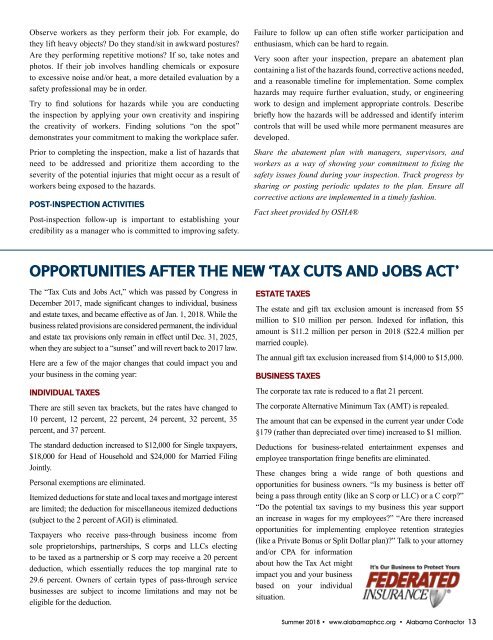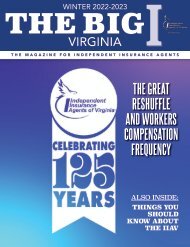Alabama Contractor Summer 2018
Create successful ePaper yourself
Turn your PDF publications into a flip-book with our unique Google optimized e-Paper software.
Observe workers as they perform their job. For example, do<br />
they lift heavy objects? Do they stand/sit in awkward postures?<br />
Are they performing repetitive motions? If so, take notes and<br />
photos. If their job involves handling chemicals or exposure<br />
to excessive noise and/or heat, a more detailed evaluation by a<br />
safety professional may be in order.<br />
Try to find solutions for hazards while you are conducting<br />
the inspection by applying your own creativity and inspiring<br />
the creativity of workers. Finding solutions “on the spot”<br />
demonstrates your commitment to making the workplace safer.<br />
Prior to completing the inspection, make a list of hazards that<br />
need to be addressed and prioritize them according to the<br />
severity of the potential injuries that might occur as a result of<br />
workers being exposed to the hazards.<br />
POST-INSPECTION ACTIVITIES<br />
Post-inspection follow-up is important to establishing your<br />
credibility as a manager who is committed to improving safety.<br />
Failure to follow up can often stifle worker participation and<br />
enthusiasm, which can be hard to regain.<br />
Very soon after your inspection, prepare an abatement plan<br />
containing a list of the hazards found, corrective actions needed,<br />
and a reasonable timeline for implementation. Some complex<br />
hazards may require further evaluation, study, or engineering<br />
work to design and implement appropriate controls. Describe<br />
briefly how the hazards will be addressed and identify interim<br />
controls that will be used while more permanent measures are<br />
developed.<br />
Share the abatement plan with managers, supervisors, and<br />
workers as a way of showing your commitment to fixing the<br />
safety issues found during your inspection. Track progress by<br />
sharing or posting periodic updates to the plan. Ensure all<br />
corrective actions are implemented in a timely fashion.<br />
Fact sheet provided by OSHA®<br />
OPPORTUNITIES AFTER THE NEW ‘TAX CUTS AND JOBS ACT’<br />
The “Tax Cuts and Jobs Act,” which was passed by Congress in<br />
December 2017, made significant changes to individual, business<br />
and estate taxes, and became effective as of Jan. 1, <strong>2018</strong>. While the<br />
business related provisions are considered permanent, the individual<br />
and estate tax provisions only remain in effect until Dec. 31, 2025,<br />
when they are subject to a “sunset” and will revert back to 2017 law.<br />
Here are a few of the major changes that could impact you and<br />
your business in the coming year:<br />
INDIVIDUAL TAXES<br />
There are still seven tax brackets, but the rates have changed to<br />
10 percent, 12 percent, 22 percent, 24 percent, 32 percent, 35<br />
percent, and 37 percent.<br />
The standard deduction increased to $12,000 for Single taxpayers,<br />
$18,000 for Head of Household and $24,000 for Married Filing<br />
Jointly.<br />
Personal exemptions are eliminated.<br />
Itemized deductions for state and local taxes and mortgage interest<br />
are limited; the deduction for miscellaneous itemized deductions<br />
(subject to the 2 percent of AGI) is eliminated.<br />
Taxpayers who receive pass-through business income from<br />
sole proprietorships, partnerships, S corps and LLCs electing<br />
to be taxed as a partnership or S corp may receive a 20 percent<br />
deduction, which essentially reduces the top marginal rate to<br />
29.6 percent. Owners of certain types of pass-through service<br />
businesses are subject to income limitations and may not be<br />
eligible for the deduction.<br />
ESTATE TAXES<br />
The estate and gift tax exclusion amount is increased from $5<br />
million to $10 million per person. Indexed for inflation, this<br />
amount is $11.2 million per person in <strong>2018</strong> ($22.4 million per<br />
married couple).<br />
The annual gift tax exclusion increased from $14,000 to $15,000.<br />
BUSINESS TAXES<br />
The corporate tax rate is reduced to a flat 21 percent.<br />
The corporate Alternative Minimum Tax (AMT) is repealed.<br />
The amount that can be expensed in the current year under Code<br />
§179 (rather than depreciated over time) increased to $1 million.<br />
Deductions for business-related entertainment expenses and<br />
employee transportation fringe benefits are eliminated.<br />
These changes bring a wide range of both questions and<br />
opportunities for business owners. “Is my business is better off<br />
being a pass through entity (like an S corp or LLC) or a C corp?”<br />
“Do the potential tax savings to my business this year support<br />
an increase in wages for my employees?” “Are there increased<br />
opportunities for implementing employee retention strategies<br />
(like a Private Bonus or Split Dollar plan)?” Talk to your attorney<br />
and/or CPA for information<br />
about how the Tax Act might<br />
impact you and your business<br />
based on your individual<br />
situation.<br />
<strong>Summer</strong> <strong>2018</strong> • www.alabamaphcc.org • <strong>Alabama</strong> <strong>Contractor</strong> 13


















